Discover Florida Nature
It's time to explore the natural Florida


|
|
|
| Florida Poison Control Center 1-800-222-1222 | |
|
|
|
With such an abundance of plant life in the state of Florida, it isn't
surprising that some of these plants or toxic. Poisonous plants may be
harmful or fatal if swallowed, or they may cause a reaction just by
touching them. When dealing with plants in the wild it is important to
remember a few simple pointers. Recognize the plants in your
surroundings. Read through our list of poisonous plants in Florida and
familiarize yourself with plants that are in your area. Always purchase
non-toxic plants for your home and garden. -Remove and destroy poisonous plants from your home and garden and ask your neighbors to do the same. The safest way to avoid poisoning is to remove any toxic plants in your home environment. -Teach children that putting leaves, stems, flowers, seeds, berries or wild mushrooms in their mouths is dangerous. Be aware that these plants may also be poisonous to pets. -Keep a bottle of Syrup of Ipecac in your home (do not use unless instructed to do so by your physician or the poison information center).Keep a Poison Information Center number near your telephone. Call the Poison Center immediately at 1-800-222-1222. If asked to go to the emergency room take part of the plant, seeds, or berries with you to aid identification. -Never eat wild mushrooms and destroy mushrooms that appear in the yard. Forage for your mushrooms in the produce department of your grocery store. -If you suspect possible poisoning from a plant : Remove all plant pieces from mouth. Rinse mouth and lips with cool water. Offer sips of water to drink. Wash hands with soap and water. Read through our list of poisonous or toxic plants found in Florida and make sure your families and pets are protected. We have a photograph of each toxic plant to help you determine which plants are unsafe in your yard or landscape. Click on the thumbnail photo to see a larger image! 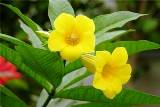 (Yellow)
Alamanda
(Allamanda Cathartica)- All parts of the plant contain allamandin, a
toxic iridoid lactone. The leaves, roots and flowers may be used in the
preparation of a powerful cathartic (hence the name); the milky sap is
also known to possess antibacterial and possibly anticancer properties.
Gardeners exposed to the sap will develop rashes, itch, and blisters. (Yellow)
Alamanda
(Allamanda Cathartica)- All parts of the plant contain allamandin, a
toxic iridoid lactone. The leaves, roots and flowers may be used in the
preparation of a powerful cathartic (hence the name); the milky sap is
also known to possess antibacterial and possibly anticancer properties.
Gardeners exposed to the sap will develop rashes, itch, and blisters.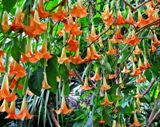 Angels
Trumpet (Brugmansia)- All parts of Brugmansia plants
contain dangerous levels of poison and may be fatal if ingested by
humans or animals, including livestock and pets. Contact with the eyes
can cause pupil dilation (mydriasis) or unequal pupil size (anisocoria).
Some municipalities prohibit the purchase, sale, or cultivation of
Brugmansia plants. When flowers, leaves or seeds are eaten, problems
such as dry mouth, muscle weakness, high blood pressure, fast pulse,
difficult urination, confusion, flushed skin, fever, dilated pupils,
blurred vision and constipation can occur. Angels
Trumpet (Brugmansia)- All parts of Brugmansia plants
contain dangerous levels of poison and may be fatal if ingested by
humans or animals, including livestock and pets. Contact with the eyes
can cause pupil dilation (mydriasis) or unequal pupil size (anisocoria).
Some municipalities prohibit the purchase, sale, or cultivation of
Brugmansia plants. When flowers, leaves or seeds are eaten, problems
such as dry mouth, muscle weakness, high blood pressure, fast pulse,
difficult urination, confusion, flushed skin, fever, dilated pupils,
blurred vision and constipation can occur.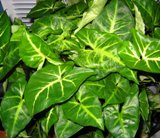 Arrowhead (Syngonium
podophyllum)- This plant has large, arrow shaped leaves and comes in a
variety of gorgeous colors, from bright green to a muted pink. Because
the sap from Syngonium is an irritant, it will appear on lists of
poisonous plants. The arrowhead plant goes by numerous names including
arrowhead vine, American evergreen, five fingers, and nephthitis. Arrowhead (Syngonium
podophyllum)- This plant has large, arrow shaped leaves and comes in a
variety of gorgeous colors, from bright green to a muted pink. Because
the sap from Syngonium is an irritant, it will appear on lists of
poisonous plants. The arrowhead plant goes by numerous names including
arrowhead vine, American evergreen, five fingers, and nephthitis. 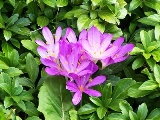 Autumn
Crocus (Colchicum autumnale)- Autumn crocus has been mistaken
by foragers for ramsons, which it vaguely resembles, but it is a deadly
poison due to the presence of colchicine, a useful drug with a narrow
therapeutic index. The symptoms of colchicine poisoning resemble those
of arsenic and there is no antidote. Despite its toxicity, colchicine is
an approved treatment for gout and is also used in plant breeding to
produce polyploid strains. Autumn
Crocus (Colchicum autumnale)- Autumn crocus has been mistaken
by foragers for ramsons, which it vaguely resembles, but it is a deadly
poison due to the presence of colchicine, a useful drug with a narrow
therapeutic index. The symptoms of colchicine poisoning resemble those
of arsenic and there is no antidote. Despite its toxicity, colchicine is
an approved treatment for gout and is also used in plant breeding to
produce polyploid strains. Brazilian
Pepper-Tree
(Schinus terebinthifolius)- The family Anacardiaceae contains
poison ivy, poison oak, poison sumac, and Schinus terebinthifolius,
or Brazilian pepper-tree. People sensitive to poison ivy, oak or sumac
may also be allergic to Brazilian pepper tree because it also has the
potential to cause dermatitis to those with sensitive skin. Some people
have also expressed respiratory problems associated with the bloom
period of pepper tree. Brazilian
Pepper-Tree
(Schinus terebinthifolius)- The family Anacardiaceae contains
poison ivy, poison oak, poison sumac, and Schinus terebinthifolius,
or Brazilian pepper-tree. People sensitive to poison ivy, oak or sumac
may also be allergic to Brazilian pepper tree because it also has the
potential to cause dermatitis to those with sensitive skin. Some people
have also expressed respiratory problems associated with the bloom
period of pepper tree.  Caladium
(Caladium x hortulanum)- Caladium are easy to grow. They are tropical
plants, native to the Amazon river area of Brazil. So, it's no surprise
that these plants love a warm, shady, humid environment. Caladium is
grown as an ornamental plant for it's colorful leaves. The leaves come
in a variety of combinations of green, with white, pink or red. It grows
to it's full height of 12" to 30" in one season. Ingestion can cause
severe irritation to the mouth and throat and may also be an irritant to
the G.I. tract. Children as well as cats, dogs and other family pets
that may nibble on the foliage are all at risk. Lake Placid, Florida
claims to be the Caladium capital of the world. Caladium
(Caladium x hortulanum)- Caladium are easy to grow. They are tropical
plants, native to the Amazon river area of Brazil. So, it's no surprise
that these plants love a warm, shady, humid environment. Caladium is
grown as an ornamental plant for it's colorful leaves. The leaves come
in a variety of combinations of green, with white, pink or red. It grows
to it's full height of 12" to 30" in one season. Ingestion can cause
severe irritation to the mouth and throat and may also be an irritant to
the G.I. tract. Children as well as cats, dogs and other family pets
that may nibble on the foliage are all at risk. Lake Placid, Florida
claims to be the Caladium capital of the world.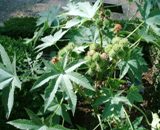 Castor Beans (Ricinus communis)-The castor bean plant
is prized for its castor oil and full, fast-growing leaves, but the
castor beans it bears produces a deadly poison that kills people within
days. Castor beans contains a toxic protein called ricin, which releases
when chewed, mashed, or finely ground. Several tell-tale symptoms occur
within 12 hours of ingesting castor beans, with deadly symptoms arising
in one to three days. Swallowing a chewed or split bean can cause bloody
vomiting, diarrhea, abdominal pain, drowsiness and death from liver or
kidney damage. Castor Beans (Ricinus communis)-The castor bean plant
is prized for its castor oil and full, fast-growing leaves, but the
castor beans it bears produces a deadly poison that kills people within
days. Castor beans contains a toxic protein called ricin, which releases
when chewed, mashed, or finely ground. Several tell-tale symptoms occur
within 12 hours of ingesting castor beans, with deadly symptoms arising
in one to three days. Swallowing a chewed or split bean can cause bloody
vomiting, diarrhea, abdominal pain, drowsiness and death from liver or
kidney damage. |
|
|
Advertise | Privacy Statement | Dog Encyclopedia | Video |Contact | Alaska Nature |
|